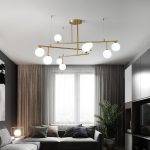
As we enter a new decade, interior design continues to evolve at a rapid pace. From bold colors to intricate patterns, homeowners are exploring new ways to make their living spaces stand out. And one area that’s seeing a lot of innovation is ceiling design. In this article, we’ll take a closer look at some of the latest trends in this field, and explore how designers are using the ceiling to create truly unique spaces.
Section 1: The Rise of the Statement Ceiling
The Importance of the Ceiling
For too long, ceilings have been ignored in interior design. Often, they’re simply painted white and left bare, while all the attention is focused on the walls and furnishings. But this is changing, as designers realize that the ceiling is a key part of any room. Not only does it provide a visual counterpoint to the rest of the space, but it can also influence the way we perceive a room’s size and shape.
Embracing Bold Colors and Patterns
One way designers are making the ceiling the focal point of a room is by using bold colors and patterns. Instead of settling for a plain white surface, homeowners are opting for striking shades of blue, green, or even black. And when it comes to patterns, the sky is the limit. From geometric shapes to botanical prints, there’s no shortage of options for those looking to create a statement ceiling.
Adding Texture and Depth
Another way designers are making the most of the ceiling is by adding texture and depth. Whether it’s through the use of wood paneling, exposed beams, or even wallpaper, these elements can create a sense of warmth and intimacy in a room. And by combining different textures, designers can create a dynamic visual experience that draws the eye up and makes the ceiling the star of the show.
Section 2: Innovations in Lighting
The Power of Illumination
Lighting is an essential part of any interior design scheme, and it’s particularly important when it comes to the ceiling. Through the strategic use of lights, designers can create a variety of effects that add depth and drama to a space. From hidden fixtures that create a soft, diffused glow to statement chandeliers that become the centerpiece of a room, lighting can transform a ceiling from a passive surface to an active and engaging feature.
Smart Home Technology
With the advent of smart home technology, lighting has become even more versatile. Homeowners can now control their lights with a variety of apps and voice assistants, allowing them to adjust the brightness and color of their ceiling illumination with ease. And with the rise of LED bulbs, it’s easier than ever to create a customized lighting scheme that’s both energy-efficient and visually stunning.
Integration with Other Design Elements
In addition to being a focal point in its own right, the ceiling can also be integrated with other design elements to create a cohesive and harmonious space. For example, designers may choose to use lighting to highlight a particular piece of artwork, or to draw attention to a specific architectural feature. By using lighting as part of a larger design strategy, homeowners can create a space that feels truly integrated and intentional.
Section 3: Sustainability and Functionality
The Green Ceiling
As our society becomes increasingly concerned with sustainability, designers are exploring ways to make the ceiling more eco-friendly. This can take many forms, from the use of recycled materials in ceiling tiles to the installation of green roofs on commercial buildings. By incorporating sustainable practices into their ceiling design, designers can help to reduce the environmental impact of a building while also creating a unique aesthetic experience.
Functionality and Acoustics
In addition to being visually stunning, the ceiling can also serve an important functional purpose. For example, ceiling tiles designed with soundproofing materials can help to muffle noise and create a more peaceful environment. And in commercial spaces, ceilings can be used for practical purposes such as the installation of air conditioning or security systems. By incorporating functionality into their ceiling design, designers can create spaces that are both beautiful and practical.
The ceiling may not be the first thing that comes to mind when we think of interior design, but as we’ve seen in this article, it’s an area that’s ripe for innovation and creativity. Whether through the use of bold colors and patterns, innovative lighting strategies, or sustainable materials, designers are finding new ways to make the ceiling an essential part of any room. So if you’re looking to create a jaw-dropping, unforgettable space, be sure to look up – you never know what you might find!







